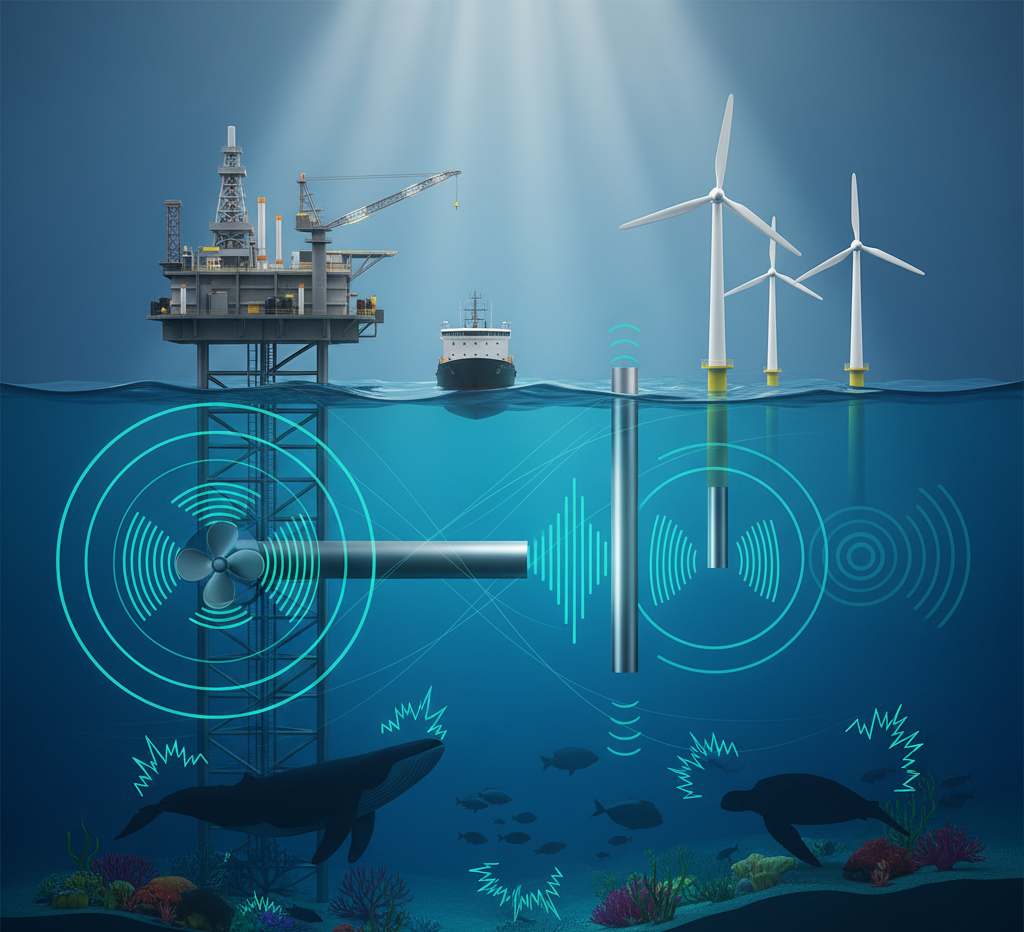
Silence Isn’t Always Peaceful
When most people imagine the ocean, they picture serenity: blue horizons, gentle waves, and silence.
But the truth is far louder.
Today’s oceans hum with the sound of human activity — ships, offshore drilling, seismic surveys, and renewable installations all contribute to an expanding underwater soundscape. This isn’t just background noise; it’s a new form of acoustic pollution that can travel hundreds of kilometers underwater.
Research now shows that Underwater Noise in offshore energy, from propellers, thrusters, and pile-driving operations, can disrupt marine life communication, interfere with navigation, and even alter migration patterns. The ocean, once the quietest ecosystem on Earth, is now one of the noisiest.
And while this invisible pollution doesn’t fill the air or spill oil on beaches, its impact on marine health and offshore operations is profound.
For decades, offshore engineers, energy developers, and shipbuilders have worked toward a common goal: expanding cleaner and more efficient energy systems. Yet as technology advances, so does its acoustic footprint.
Renewable energy installations — such as offshore wind farms — require pile driving and heavy marine operations that generate high decibel levels. Oil and gas platforms use pumps, compressors, and generators that transmit vibration through steel and seawater. Even research and construction vessels add to the cumulative noise that reverberates across marine corridors.
This growing soundscape brings real challenges:
- Project delays caused by environmental compliance issues.
- Public pressure over the ecological impact of industrial noise.
- Operational inefficiencies from poorly managed vibration.
For many operators, these issues aren’t just technical — they are also reputational and regulatory. Balancing progress with protection is no longer optional; it’s a prerequisite for project approval and long-term sustainability.
Engineering Quieter Waters
At Acoustic Solutions Pte. Ltd., we help offshore and energy companies turn sound into a measurable sustainability metric.
Our engineers specialize in noise prediction, vibration diagnostics, and compliance strategies that ensure operations perform safely and quietly — without compromising productivity.
We combine scientific modeling with real-world data to design systems that meet international standards such as:
- IMO Guidelines for Underwater Noise (MEPC.1/Circ.833)
- DNV URN Notations
- World Health Organization (WHO) Environmental Noise Guidelines
Our core services include:
✅ Underwater Radiated Noise (URN) Assessments
Identify, model, and quantify acoustic emissions from propellers, hull flow, and dynamic positioning thrusters.
✅ Noise Propagation Modeling
Predict how sound travels through water and various structures — a crucial understanding for impact assessments and environmental permitting.
✅ Vibration Isolation & Mitigation Design
Engineer damping, mounting, and insulation systems to reduce transmitted noise at the source.
✅ Environmental & Regulatory Compliance Support
Prepare technical documentation, predictive reports, and monitoring plans aligned with regional and international HSE requirements.
This knowledge matters most to those shaping the future of the energy and maritime sectors:
- Offshore operators seeking to reduce URN and comply with IMO and DNV standards.
- Renewable developers building wind, tidal, and hydrogen projects with sustainable soundscapes.
- Shipyards and naval architects designing vessels optimized for quiet operation and marine protection.
- Environmental consultants and regulators ensuring compliance across the project lifecycle.
For these professionals, acoustic engineering isn’t just about silence — it’s about stewardship.
Integrating acoustic control early in design prevents costly retrofits, builds trust with regulators, and enhances a company’s environmental reputation.
Sound as the Next Sustainability Frontier
As nations pursue Net Zero goals and the energy transition accelerates, attention is shifting beyond carbon emissions. Noise is emerging as a new sustainability metric — one that links engineering excellence with ecological responsibility.
Just as the world learned to measure air and water quality, the next era of environmental accountability will measure acoustic footprints.
At Acoustic Solutions Pte. Ltd., we stand at that intersection — where science meets sustainability. Our mission is to help industry lead responsibly, using sound as both a diagnostic and a design tool.
Because sustainability isn’t silent — it’s engineered.
👉 Partner with Acoustic Solutions Pte. Ltd. to design the next generation of quiet, compliant, and efficient offshore systems.
Protect the ocean. Improve performance. Lead responsibly.
Let’s make progress sound better.
